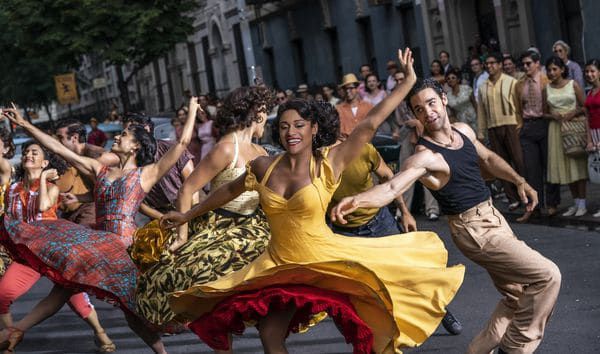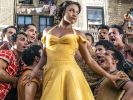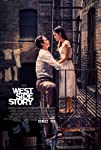Eye For Film >> Movies >> West Side Story (2021) Film Review
West Side Story
Reviewed by: Andrew Robertson

We open in darkness, with a whistle. Then something almost black and white, the clearance of slums. Coming soon The Lincoln Center, and here our recursions begin. In 1968, that building hosted a revival of the musical set, if not there, then on the San Juan Hill that had surrounded it.
Let us not call this a remake. It might be, but there are distinctions here. Even as I write this the 1961 film is playing in the background, and it's all splash of colour, brownstones dense from a high eye. This, Spielberg's, has a different verticality, a prowling from above. Hatches open, a group assembles, weaving through a different version of the same place. A different eye. Different dancers on differently constructed streets, clicking fingers and choreography in service of the same tale, six decades on.

What remains? Hollywood spectacle. Musical magic. The scale of screen supports set-pieces and vantages no theatre could support. The box that makes this possible isn't in the wings or the gods, but the camera. Janusz Kaminski has lensed nearly a score of films for Spielberg and the quality of their collaboration continues. There's detail everywhere, in each set and seam and stoop. Detail added too by a set of recontextualisations, changes that have to be read as a restaging rather than a remake.
There are still piles of rubble, but the inciting graffiti is now a flag and not a tag. The scale of some of these backlots is as large but it's in the small that things start to tell. What, in 1961, is a bloodied ear is something more penetrating here, Spielberg nailing his colours to the mast. This is almost self-consciously more filmic. Lens flare appears in a few places, with what feels the same artificiality as it appearing in videogames but perhaps for the same sense of layered verisimilitude. A stained glass window serves to cast teal and orange on young lovers after they've been diegetically lit by conveniently placed spots. Quite what the imagined plan for romantic shadow under the gymnasium bleachers was is uncertain, but it's the fluorescents upon the powder-room pow-wow that come the closest to washing out.
Some of the songs are re-ordered, the placement of I Feel Pretty is now heartbreaking. Tony Kushner has worked with Spielberg twice before, will have been helping with the somewhat autobiographical Fabelmans in the near future. They're working with strong material though, Robbins, Bernstein, Sondheim, Laurents all created something that has stood the test of time. Against the ten Oscars for the film the two Tonys start to look pale.
The language remains somewhat difficult, there are plenty of contemporary slurs. Anybodys (Iris Menas) has seen the somewhat complicated "tomboy" updated to a young trans-man, played by a non-binary actor, and subjected to some discomfiting language. Other gender rebalancing includes Rita Moreno's role as Valentina, effectively replacing Doc at the druggists and, as is explained, more adequately explaining how the shop became neutral turf. Shots from outside highlight the scale of the demolition, the long arms of the wreckers looming across like dinosaurs.
The cast is large, Josh Andres Rivera as Chino makes a transition from stage, previously part of the Hamilton cast. If you count Baby Driver this isn't Ansel Elgort's first musical, but that glaikit diffidence works in combination and contrast with Rachel Zegler's intensity and naivete as Maria. Ariana DeBose and David Alvarez as Anita and Bernardo manage both the 'loco' and 'in loco parentis'. Even small changes, like the introduction of the red to Maria's dress, help highlight character and circumstance. Mike Faist's Riff is a figure perhaps even more tragic.
Tony has been short for Anton since Irving Shulman novelised Laurents' book (at least), but read against other changes the make-up of the Jets (and lack of upon the Sharks) now has more depths. Maria may wear a white dress but whiteness is a term that has already seen some flexibility in those now 48 states. It's yet another bit of sensitivity in an update, a restaging, a revival. Yet the language of film is such that we will inevitably refer to it as a remake.
It's the May 1957 copy of Popular Science on one of the racks, "Why You Can't Outrun The Police". While Krupke and Schrank (Brian d'Arcy James and Corey Stoll) represent the long arm of the law they're also the closest to external authority anywhere on screen. In a protest a sign mentions the literal structural racist Robert Moses, elsewhere a painted sign in a department store echoes (if not inspires) lyrics, a sky seems the spread of pigment by some brush or another.
In places the filmmaking verges on showing off. Multiple mirrors make the managing of reflections a challenge, but it's as much a demonstration of technique as a pirouette or a solo. Songs that had taken place in single locations are given scope to roam, a challenge to all involved but delightful for it. It's that which most commends what we may end up calling Spielberg's West Side Story. The first film is still special, but how many Robert Wise films can you name? You undoubtedly know of more of them than you think, but how easy is that connection to make? The state of the art in filmmaking has moved quite a bit in 60 years, and here perhaps we have a talent behind the camera to match those of the lyricists, composers, and playwrights who first decided to steal the work of Matteo Bandello.
Reviewed on: 09 Dec 2021If you like this, try:
The Power Of The DogThe Sound Of Music
William Shakespeare’s Romeo And Juliet


















